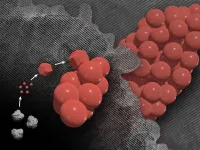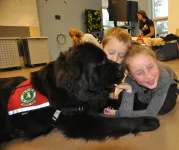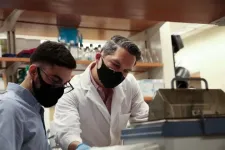(Press-News.org) When materials reach extremely small size scales, strange things begin to happen. One of those phenomena is the formation of mesocrystals.
Despite being composed of separate individual crystals, mesocrystals come together to form a larger, fused structure that behaves as a pure, single crystal. However, these processes happen at scales far too small for the human eye to see and their creation is extremely challenging to observe.
Because of these challenges, scientists had not been able to confirm exactly how mesocrystals form.
Now new research by a Pacific Northwest National Laboratory (PNNL)-led team used advanced transmission electron microscopy (TEM) techniques to see mesocrystals form in solution in real time. What they saw runs contrary to conventional wisdom and their insights could one day help scientists design materials for energy storage and understand how minerals in soil form.
Rather than individual crystals nucleating, the step that begins crystal formation, and then randomly aggregating into mesocrystals in two unrelated steps, the researchers observed that nucleation and attachment were closely coupled in forming these highly uniform structures. The researchers reported their work in the February 18, 2021 issue of Nature.
"Our findings identify an important new pathway of crystallization by particle attachment and resolve key questions about mesocrystal formation," said PNNL and University of Washington materials scientist Guomin Zhu. He was part of the research team led by Jim De Yoreo, PNNL materials scientist and co-director of the Northwest Institute for Materials Physics, Chemistry, and Technology. "We suspect this is a widespread phenomenon with significant implications both for the synthesis of designed nanomaterials and for understanding natural mineralization," Zhu added.
Seeing crystallization in real-time
The project took years to execute and required significant problem solving. For the microscopy experiments, the scientific team chose a model system that included hematite, an iron compound commonly found in the Earth's crust, and oxalate, a naturally abundant compound in soil.
They visualized the process using in situ TEM, which gives researchers the ability to see crystallization at the nanometer scale as it happens. They combined this real-time method with "freeze-and-look" TEM that enabled them to follow an individual crystal at different points during growth. Theoretical calculations helped complete the picture, allowing the PNNL team to piece together how the mesocrystals grew.
Researchers generally run most in situ TEM experiments at room temperature to simplify the experimental setup and minimize the potential for damaging the sensitive instrument, but mesocrystal formation rapid enough to observe occurs at around 80 °C.
"The additional equipment used to heat the samples made the experiments extremely challenging, but we knew the data would be key to understanding how the mesocrystals were forming," said Zhu.
Once heated, the new hematite nanocrystals make it easy for them to rapidly attach together, which leads, on average, to final mesocrystals of approximately the same size and shape.
Mesocrystals in nature
The chemical key to this rapid, reliable attachment is the oxalate molecules present in the solution. After the first few small crystals form, the oxalate additives help create a chemical gradient at the interface of the liquid and the growing crystal. More chemical components necessary for particle nucleation linger near the crystals, which dramatically increases the likelihood that new particles will form near existing ones.
While this crystal growth pathway was observed in controlled conditions at very small scales, it likely also occurs in natural systems, according to the researchers. Some mineral deposits, including an Australian hematite deposit, contain mesocrystals. Given the natural abundance of oxalate and the PNNL team's observation that hematite can become mesocrystals at temperatures as low as 40 °C, it seems plausible that this formation route occurs in nature.
Because mesocrystals are found throughout nature, the findings can be applied to understanding nutrient cycling in the environment, among other applications. Moreover, the route to creating near-uniform complex structures requires an understanding of how methods for forming such materials work and how to control them. Thus this work, supported by the U.S. Department of Energy, Office of Science, Office of Basic Energy Sciences, Division of Chemical Sciences, Geosciences, and Biosciences, opens new possibilities to intentionally create mesocrystals or mesocrystal-like materials.
INFORMATION:
The high-resolution imaging and simulations were performed in EMSL, the Environmental and Molecular Sciences Laboratory, a DOE Office of Science User Facility located at PNNL. In addition to Zhu and De Yoreo, this work features contributions from PNNL researchers Maria Sushko, John Loring, Benjamin Legg, Miao Song, Jennifer Soltis, Xiaopeng Huang, and Kevin Rosso.
Pacific Northwest National Laboratory draws on signature capabilities in chemistry, Earth sciences, and data analytics to advance scientific discovery and create solutions to the nation's toughest challenges in energy resiliency and national security. Founded in 1965, PNNL is operated by Battelle for the U.S. Department of Energy's Office of Science. DOE's Office of Science is the single largest supporter of basic research in the physical sciences in the United States and is working to address some of the most pressing challenges of our time. For more information, visit the PNNL's News Center. Follow us on Facebook, LinkedIn, Twitter, and Instagram.
A considerable portion of the efforts to realize a sustainable world has gone into developing hydrogen fuel cells so that a hydrogen economy can be achieved. Fuel cells have distinctive advantages: high energy-conversion efficiencies (up to 70%) and a clean by-product, water. In the past decade, anion exchange membrane fuel cells (AEMFC), which convert chemical energy to electrical energy via the transport of negatively charged ions (anions) through a membrane, have received attention due to their low-cost and relative environment friendliness compared ...
CHAMPAIGN, Ill. -- Researchers who focus on fat know that some adipose tissue is more prone to inflammation-related comorbidities than others, but the reasons why are not well understood. Thanks to a new analytical technique, scientists are getting a clearer view of the microenvironments found within adipose tissue associated with obesity. This advance may illuminate why some adipose tissues are more prone to inflammation - leading to diseases like type 2 diabetes, cancer and cardiovascular disorders - and help direct future drug therapies to treat obesity.
In a new study, University of Illinois ...
A short-lived resurgence in the emission of ozone depleting pollutants in eastern China will not significantly delay the recovery of Earth's protective "sunscreen" layer, according to new research published Feb. 10 in Nature.
Stratospheric ozone, also known as Earth's ozone layer, helps shield us from the Sun's harmful Ultraviolet (UV) rays. Compounds like CFC-11 (Trichlorofluoromethane, also known as Freon-11), a chemical once considered safe and widely used as a refrigerant and in the production of insulation for buildings, rise to the stratosphere after emission on Earth's surface. Once in the atmosphere, CFC's are broken down by the UV light and result in the destruction of ozone molecules, both reducing stratospheric ozone concentrations globally ...
A neural network system that analyzes photographs can rank and distinguish suspicious, potentially precancerous skin lesions, which can turn into the deadly skin malignancy melanoma if not caught and removed early. The system accurately scoped out suspicious lesions from 68 patients in a manner that mostly matched tried-and-true evaluations from dermatologists. The results suggest the platform could help clinicians spot suspicious lesions during clinical visits faster and on a larger scale, potentially allowing for earlier diagnosis and treatment. Melanoma is ...
Understanding the molecular biology of brain tumors is key to prognosis and treatment said Le Bonheur Neuroscience Institute Co-Director Frederick Boop, MD, in his presentation "How Molecular Biology Impacts Clinical Practice" at the International Society for Pediatric Neurosurgery (ISPN) 2020 Virtual Meeting.
"Historically we have depended on what we see under a microscope to differentiate tumor types and determine prognosis and therapy," said Boop. "We know now that what we see doesn't necessarily predict how these tumors are going to behave."
Physicians are able to send a piece of a child's tumor to FoundationOne, an FDA-approved tissue-based broad companion diagnostic (CDx) for solid tumors, which provides the genomic alterations of that particular tumor. ...
A new UBC Okanagan study finds children not only reap the benefits of working with therapy dogs-they enjoy it too.
"Dog lovers often have an assumption that canine-assisted interventions are going to be effective because other people are going to love dogs," says Nicole Harris, who conducted this research while a master's student in the School of Education. "While we do frequently see children improve in therapy dog programs, we didn't have data to support that they enjoyed the time as well."
Harris was the lead researcher in the study that explored how children reacted while participating in a social skill-training program with therapy dogs.
The research saw 22 children from the Okanagan Boys and Girls ...
Resistance to tangle formation may help preserve memory
SuperAgers have fewer tangles than normally aging individuals
Future research to see how SuperAgers are protected
CHICAGO - A new Northwestern Medicine study showed cognitive SuperAgers have resistance to the development of fibrous tangles in a brain region related to memory and which are known to be markers of Alzheimer's disease.
The tangles are made of the tau protein which forms structures that transport nutrients within the nerve cell. These tangles disrupt the cell's transport system, ...
Nearly a half-million people a year die from sudden cardiac death (SCD) in the U.S. -- the result of malfunctions in the heart's electrical system.
A leading cause of SCD in young athletes is arrhythmogenic cardiomyopathy (ACM), a genetic disease in which healthy heart muscle is replaced over time by scar tissue (fibrosis) and fat.
Stephen Chelko, an assistant professor of biomedical sciences at the Florida State University College of Medicine, has developed a better understanding of the pathological characteristics behind the disease, as well as promising avenues for ...
The trial found that using sensor-based asthma inhalers may improve control of the condition and improve the quality of life for caregivers.
Greatest gains were among non-Hispanic Black participants, who experience more frequent and severe asthma than other groups.
Based on the study results, this asthma intervention should be considered for use by primary care, allergy and pulmonary care providers, to help engage diverse populations of pediatric asthma patients and their caregivers.
CHICAGO (February 17, 2021) -- Sensor-based inhalers integrated into health care providers' clinical workflows may help improve medication adherence and support children with asthma - and their families - to more effectively manage this condition, according ...
Numerous studies have shown that trained dogs can detect many kinds of disease -- including lung, breast, ovarian, bladder, and prostate cancers, and possibly Covid-19 -- simply through smell. In some cases, involving prostate cancer for example, the dogs had a 99 percent success rate in detecting the disease by sniffing patients' urine samples.
But it takes time to train such dogs, and their availability and time is limited. Scientists have been hunting for ways of automating the amazing olfactory capabilities of the canine nose and brain, in a compact device. Now, a team of researchers at MIT and other institutions has come up with a system that can detect the chemical and microbial content of an air sample with ...





